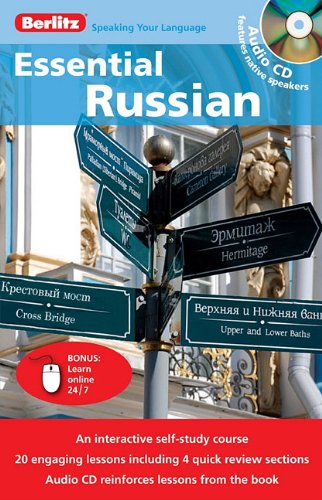A lot of people (or publishers) might get mad at me if they heard me say this, but I normally do not expect to find any worthwhile language books when I visit your typical chain bookstore. Most do not tend to have any of the cutting-edge textbooks, a majority of which are published by universities, and not by the familiar, big name publishers whose books tend to fill the shelves at Barnes and Noble. During a recent trip to my local bookstore, however, I was pleasantly surprised with Berlitz's Essential Russian. Today I would like to share with you my review of this book – which I find to be quite a respectable text for introductory Russian.
When taking a first look at this book, the cheesy marketing lingo and appearance will likely be familiar to anyone who has browsed the foreign language section of a typical bookstore. A quick peek inside will also reveal shameless claims, like: “Learn easier than ever!” and “Quickly progress to speak with the mastery of a native speaker!”, but don't let this deceive you about the quality of the book's content. It is quite apparent to me that the authors knew exactly what they were doing when constructing this course, and, aside from a few areas that could be improved, they have produced a very solid language text. The book's lessons are formatted as follows:
Dialogue (often including a narrative) Grammar Vocabulary Exercises
In addition to the lessons, there is an introduction, key to all the exercises, and Russian-English glossary.
Before moving on to talk about the content of the lessons, I will say a few words about the introduction. The introduction itself is very short, but relatively effective in communicating all the necessary points. The authors explain the content of the course, how the students should approach learning, and what their expectations should be. It is not much, but I appreciate an introduction like this that gives some direction to students.

The first lesson can also be considered somewhat of an introduction, as it does not follow the format followed by the rest of the lessons, but instead, is completely devoted to teaching pronunciation, the writing system, and a few basics about the language. I didn't find this lesson to be particularly helpful in itself, but it would probably be adequate when supplemented with the guidance of an instructor. I think many of the explanations in the pronunciation section fall somewhat short, and there is no audio for this portion, so students will need to make use of outside resources.
Once you finish the introductory lesson, it's on to the real meat of the book and your first dialogue. For the most part, I found the dialogues to be high quality, covering relatively useful topics. There are some instances where the dialogues sound a bit unnatural and perhaps a little boring, but I found several reasons to like the way the authors wrote the dialogues.
First of all, most of the situations that the speakers find themselves in seem very plausible. Unlike many textbooks, which create dialogues around contrived situations which are primarily based around tourist activities, this book gives plenty of examples of plain everyday conversations. There are also dialogues which are based around travel and interactions a foreigner is likely to have, which makes sense for an introductory text.
Secondly, each line of the dialogue is presented in Russian alphabet, a phonetic transliteration (for the first ten lessons), and an English translation. I am usually of the opinion that transliteration systems are silly and not needed for language textbooks, but I think this one actually serves a useful purpose, as the quality of Russian vowels and consonants can change in different environments. Throughout the book, stressed syllables are marked with an accent mark in the Russian text, which was another feature I found to be useful. I was also happy with how the authors made an effort to put simple phrases, like asking for the time of day or what day it is, into a natural context in the dialogues. I think that students will find this makes memorizing such phrases easier, as opposed to practicing them in complete isolation.
Lastly, the dialogues feature recurring characters throughout the book, which I think is a necessity for any good introductory text in order to draw the interest of the students and create a feeling of continuity.
The book includes a CD with recordings of each dialogue and narrative from the lessons. Recordings for the dialogues are done by native speakers in high quality audio, and the voice acting quality is relatively good. The only complaint I would make about the recordings was that the speed of speech is obviously much slower than natural. I think it would have been great if the publishers could have included recordings at a more natural rate of speech, in addition to these, but it is hard to complain about audio being readily available for free online. Just to give an idea about the length of the dialogues, each recording is about two to three minutes long.
After the dialogue comes the grammar section. I noticed right away using this book, that the authors tend to make a lot of assumptions with their explanations. What I mean by this is that the authors include certain topics, features, and vocabulary, that the average person is probably not familiar with. In other words, without a teacher, the grammar sections will be of limited value to those who do not already have a background in linguistics or Russian. My recommendation for teachers using this book in the classroom would be to have students review the grammar sections for homework, then have them bring all their questions to class. Those that do have a background in Russian or linguistics already, however, will likely find the grammar sections to be refreshingly concise, with plenty of examples. Some lessons include a brief list of some “useful expressions” at the end of the grammar section, which some students may find useful.
"One can find audio recordings of the vocabulary online, which may be helpful for students who want to hear the words pronounced in isolation, or those that want to practice reviewing vocabulary by listening as opposed to reading."
The vocabulary section comes directly after the grammar, which I find somewhat odd, but not too great of an inconvenience. I am very satisfied with the way the book presents the vocabulary. All terms found in the dialogue, grammar, and useful expression sections are arranged in order of appearance, including the Cyrillic, transliteration (for the first ten lessons), English translation, and any relevant grammar information. “Set phrases” are presented as one whole piece, then broken down word by word, which is a great feature to help students learn. One can find audio recordings of the vocabulary online, which may be helpful for students who want to hear the words pronounced in isolation, or those that want to practice reviewing vocabulary by listening as opposed to reading. Anyone using this book should note, however, that the URL provided within the book is no longer accurate, and www.berlitzbooks.com is the current location of the website.
At the end of each lesson comes about four or five exercises. These are relatively simple, often translation or simple grammar manipulation, but I think they are sufficient for beginning learners. There is an answer key at the end of the book with solutions to all the exercises, which means that these exercises can easily be done outside of class and corrected by the students themselves, for immediate feedback. I would recommend teachers using this book to assign these exercises for homework, then create similar, more challenging exercises for use during class.
The glossary at the end of the book has only Cyrillic and English (no transliteration). It is very thorough, and includes the majority of terms that are presented in the book. For adjectives it gives forms for every gender, verbs are given with both the perfective and imperfective forms, and the gender of nouns is indicated where it is not readily obvious. It would have been helpful if they had included the number of the lesson where each term first appeared, but most students will probably not miss this feature.
While there are twenty lessons in this book, it is important to point out that every fifth lesson (6, 11, 16, 20) is a review lesson. These lessons merely show you the dialogues from the previous four lessons, and offer no new content, aside from a couple extra exercises. The audio recordings on the CD for these lessons give you the exact same recordings of the dialogues from the previous lessons, just all spliced together onto one audio track. I think that it is a good idea to offer a comprehensive review every few chapters like this, but it seems kind of silly that to provide duplicate content in the book, when users could have just flipped back to the earlier chapters (and audio tracks). It would have been better if the review lessons had been slight variations of the earlier content, instead of the exact same stuff.
One thing that is noticeably lacking in this book is any information on culture. This book contains virtually no information about Russian culture or the countries where Russian is spoken. The “supplementary materials” (advertised at the end of every lesson) on the Berlitz website are somewhat laughable. As far as I saw, it consisted of nothing more than a single PDF file with a few random links (some linking directly to Wikipedia) and one-sentence explanations. I am somewhat surprised by this, as it seems like they could have easily included some better cultural information, but I suppose it is just as easily researched by students online.
As I said at the beginning of this review, this is definitely a respectable language text. I think the authors could have changed or supplemented to elevate the status of this book from “good” to “great” with a bit more effort, but there aren't any huge complaints to be had here. I highly recommend this book for any introductory Russian class.
For teachers: Make sure your students are aware that the book probably won't address all the questions they have in regard to grammar. Tell them to write down any questions they have and bring them to class for clarification.
For students: This book doesn't provide much in the way of practicing the fundamentals of pronunciation. I recommend you make use of some of the resources available online for filling in this gap. There are also a lot of websites where you can find explanations of Russian grammar, which may help you better understand some of the points that are covered too quickly in the book.



